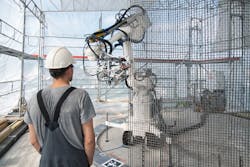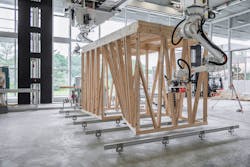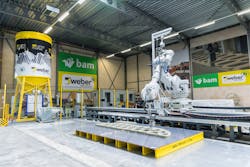In season 3 of the HBO series Westworld, robots are everywhere again, this time on construction sites. One model is George (Photo 1), whose skills include electrical and HVAC installation and site surveys.
“Dull, dirty, and dangerous no more,” says Delos, George's manufacturer. “Delos' fully autonomous androids are capable of a wide range of tasks with only limited human supervision required. Day or night, rain or shine, they work tirelessly to ensure the buildings around us are constructed faster and safer than ever before.”
Westworld is set sometime in the 2050s. Judging by today’s construction robots, George could be a reality by then. In fact, some of the marketing copy already sounds like George’s.
One example is Hilti’s Jaibot: “Overhead work for mechanical, electrical, and plumbing installation is strenuous, challenging, and time-consuming for construction workers. With the industry experiencing a skilled labor shortage, taking good care of your workforce is now more important than ever. With a construction robot like Jaibot, you can count on higher productivity and speed as it autonomously marks and drills the holes according to the digital plan.”
Another example is Boston Dynamics’ Spot, a dog-like robot capable of payloads up to 30 pounds. New York City-based Turner Construction has been testing Spot since 2020. Watch spot in action in this video.
“It was eye opening,” says James Barrett, Turner vice president and chief innovation officer. “It's like science fiction come to life. It can balance itself, jump up and down, and walk down stairs. We're walking it across an unpoured deck across the flutes. It can go up and down a big pile of rubble.”
Job-site robots aren’t a new concept. For example, the first patent for an automated bricklaying machine was filed a century ago. Today, there are models that can lay 3,000 a day — three times more than a human mason.
Spot is part of a new generation of construction robots that leverages advances in artificial intelligence, machine learning (AI/ML), and other technologies to do things that weren’t practical or even possible just a few years ago.
“Boston Dynamics is constantly upgrading the software,” Barrett says. “The autonomy has gotten much better. It could go places that it couldn't before. It's getting smarter.”
Learning on the job
Many robotics applications use building information modeling (BIM) data. In the case of Jaibot, BIM provides the coordinates for each location where a hole needs to be drilled.
“It’s then a pretty simple step to add the drill depth, diameter, and a couple of other attributes and export that from the relevant design software (usually AutoCAD or Revit) as a .CSV file,” says Aidan Maguire, business unit manager for measuring and robotics expert for Plano, Texas-based Hilti. “This .CSV file is then loaded into the Jaibot project cloud, [which] is accessed through a standard web browser.
“In the field, Jaibot is connected to the internet through a mobile data connection and will sync with the project cloud once the operator logs in. This allows live access to the project planning, allows for updates to the design if required, and syncs back the project progress, including the as-built hole locations.”
Site documentation is a common use case. For example, HoloBuilder developed SpotWalk, which mounts a 360-degree camera on Spot’s back, eliminating the man hours and potential injury of sending employees to do that documentation manually (Photo 2).
“Spot itself has advanced sensing and navigation capabilities,” says Mark Benhard, global corporate communications director for Lake Mary, Fla.-based FARO Technologies, which acquired HoloBuilder in June. “When it has been trained once for a documentation route with SpotWalk, it can walk the route autonomously and take photos. All you need are floor plans of your building — no BIM models or alike.”
Mulling the business case
Turner is one of the few contractors — of any type — using robots right now. Why? Most are still mulling the potential use cases, benefits, and costs before deciding whether to try one, let alone buy or lease one. For example, Hilti says contractors often ask about productivity, such as how many holes Jaibot can drill per hour or per day compared to an employee using traditional methods.
“This is a very difficult question to answer accurately as project conditions and the nature of the application (density of holes, diameter, drilling depth, etc.) can result in different productivity rates between projects,” Maguire says. “However, when contractors consider the entire application beyond simply the labor hours required to physically locate and drill the holes — such as reduction of rework, long- and short-term health and safety implications, and increased accuracy of installation — then even under less-than-optimum conditions, contractors can find a compelling business case.”
Boston Dynamics didn’t respond to interview requests for this article, but its website describes some of the labor savings seen in trials. One example is from a Canadian construction company: “Pomerleau anticipates being able to free-up the typically assigned employee’s time by approximately 20 hours per week based on a 500,000-square-foot project that requires nearly 5,000 images per week to properly document, allowing that employee to focus on the analysis of the captured data.”
The business case also hinges on the total cost of ownership (TCO). One analogy is drones: When mobile operators, construction companies, and other businesses began implementing drones, they had to hire or train enough people to pilot and maintain them.
“When I'm looking ahead, if we had a fleet of these [robots], that's when you'd have to start asking yourself, ‘Do I need to build up a team of robotics experts?'" says Turner’s Barrett.
Construction robots increasingly have application programming interfaces (APIs). Other vendors can use APIs to tightly integrate their products with those robots, as HoloBuilder did when it developed SpotWalk. In the future, contractors could leverage robot APIs to create in-house hardware and software.
“We may try to take advantage of the API because then we can start looking at all sorts of unique payloads that might give us a competitive advantage that nobody else has — in which case, we would want to have our own software people doing that work,” Barrett says.
Those people probably would be new hires rather than existing IT staff.
“I think it's something separate from your IT because it's a completely new and different skill set,” Barrett says. “When you get very advanced, sophisticated robots like Boston Dynamics’, that's a whole different level of knowledge you would need.”
Job killer robots?
One of robotics’ biggest selling points also is one of its biggest barriers to adoption: jobs. There’s the obvious concern that as construction robots get more sophisticated, they start to become capable of doing skilled work, too. Cautionary tales abound in other industries, such as automotive, where for decades factories have been filled with robots doing precision welding and other skilled tasks. In fact, over the past decade, the number of factory robots doubled to about 3 million. And in disparate sectors, such as agriculture, medical, transportation, hospitality, and logistics, global spending on professional service robots increased 12% between 2019 and 2020, according to the International Federation of Robotics.
On the other hand, it’s not like electrical has a glut of skilled workers, with hordes more people clamoring to enter the profession. So robots could help contractors cope with the roughly 195,000 construction job openings by shouldering some of the grunt work, freeing employees to focus on tasks worthy of their skills. One example is Dusty Robotics’ FieldPrinter, which drives around spaces such as high-rise floor plates painting architectural and structural blueprints for crews to follow.
“This is about how we can create a collaborative, augmented relationship with trade partners. What we're trying to do is free them up so that the trades can do more unique value-added work because humans have unique potential that robots will never replace,” Barrett says about Turner’s trial of Spot.
Another factor is that robots already are used for some skilled construction work — and in ways that benefit short-staffed contractors. For example, some modular home manufacturers use robots to assemble walls, including drilling holes for electrical, plumbing, and other systems. That prep enables electricians to work more efficiently when those components arrive at job sites.
To meet demand — including for affordable housing — major home builders could adopt this model to one extent or another. For instance, instead of stick building everything on-site, they could open their own prefab shops to churn out a limited number of floor plans (Photo 3). An application like 3-D printing is another possibility (Photo 4).
“Some of these national builders have 15 different floor plans,” says Chris Haynes, an instructor in the automation and robotics department at State Tech in Linn, Mo. “Maybe they mirror [this model]. ‘We can start pre-drilling holes so we don't necessarily have to have a guy that knows everything except for getting wire from point A to point B.’ And if they can get this robot to feed wire through, then they don't even need that. They'll just need the guy to come in at the end and terminate the connection.”
Flying blind
That’s still a far cry from Westworld’s George, whom some experts say won’t be possible without very deep, very elusive insights into how professionals make decisions in the field. As EC&M’s April 2021 “Job-Site Intelligence” column explained: “Job sites are chaotic, and workers in the field deal with new situations every day. Between different project teams, foremen, general contractors, and jobs, the way specific situations are handled can vary to a great extent.”
That particular column was titled “Invisible Decisions” because “what happens in the field on an electrical job site is often not visible to management.” Robot manufacturers also lack visibility, which undermines their ability to develop machines that can think and do on the fly as an electrician can.
The columns are written by consultants from MCA, a Grand Blanc, Mich.-based firm whose specialties include productivity improvement of labor, project management, estimation, and more. MCA tried building a simulation of job site decision-making but found that it didn’t replicate what goes on in the real world.
“We started saying, ‘What's missing?’” says Dr. Heather Moore, MCA vice president of operations. “The whole social atmosphere within a job site environment is part of why that discrete, logic-driven approach doesn't fit. Those guys rely a lot on their personal networks within the company [and] within the job-site environment.”
So for at least the foreseeable future, job-site robots probably will be doing more site surveys than skilled installation work. That role also will give management deeper insights into how to use their employees most effectively.
“The big picture is, we think that the application of robots or some other kind of non-human intelligence really could be more useful [for gaining] visibility into the work environment as opposed to using them to do physical tasks,” Moore says.
Will those insights eventually produce a George? Maybe.
“It's the nature of innovation that constantly there’s this incentive to keep improving. Eventually, it will all converge where you get all the pieces in place, and suddenly you're making a huge impact and potentially radically disrupting construction,” Barrett says.
Tim Kridel is an independent analyst and freelance writer. He can be reached at [email protected].
To read an online exclusive by Tom Zind about an autonomous work vehicle test at a utility-scale solar project under construction, visit https://bit.ly/3HKimP0.
About the Author
Tim Kridel
Freelance Writer
Kridel is an independent analyst and freelance writer with experience in covering technology, telecommunications, and more. He can be reached at [email protected].




